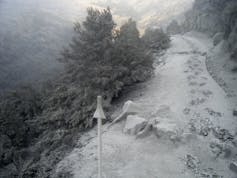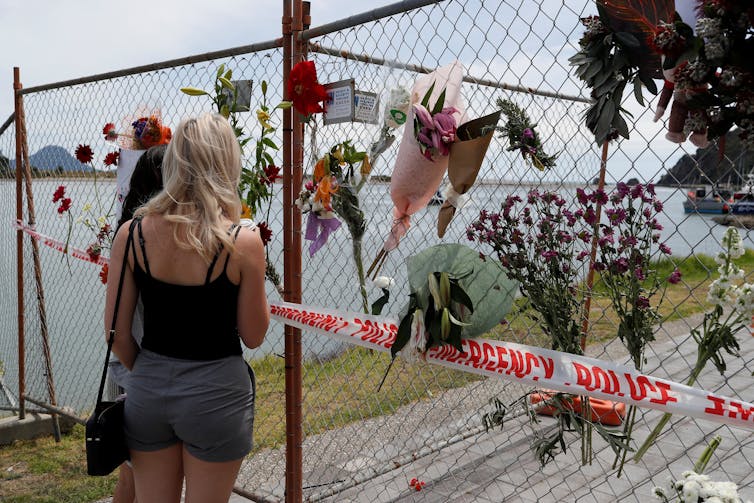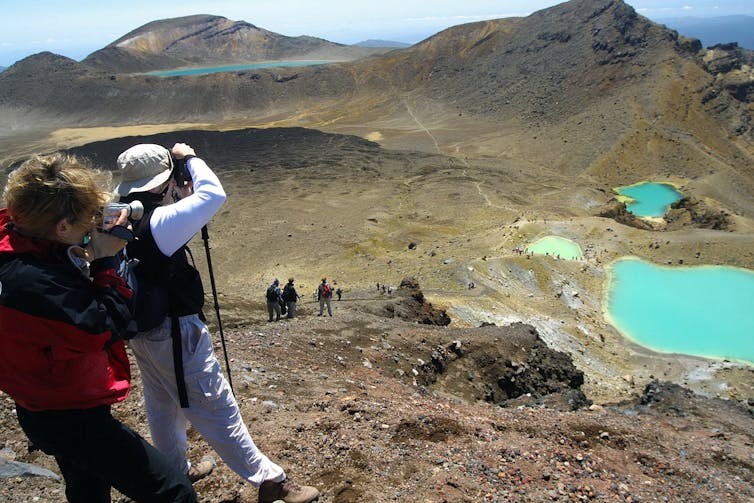Jorge
Silva/Reuters

David Dempsey and Shane Cronin
Tourists visiting Whakaari/White Island on December 9 last year had no warning of its imminent violent eruption. The explosion of acidic steam and gases killed 21 people, and most survivors suffered critical injuries and severe burns.
The tragedy prompted us to develop an early alert system. Our research shows patterns of seismic activity before an eruption that make advance warning possible. Had our system been in place, it would have raised the alert 16 hours before the volcano’s deadly eruption.

Ash
covers the ground after Mt Tongariro erupted overnight on
August 7 2012.
NZ
Police
We were also motivated by the fact that several other New Zealand volcanoes pose similar threats. Explosions and surges at the popular visitor destination Waimangu geothermal area killed three people in 1903, an eruption at Raoul Island in 2006 killed one person, ballistics at Mt Ruapehu in 2007 caused serious injuries and tourists narrowly escaped two eruptions on a popular day walk in the Tongariro national park in 2012.
Our automated warning system provides real-time hazard information and a much greater level of safety to protect tourists and help operators determine when it is safe to visit volcanoes.
Read more:
Why
White Island erupted and why there was no warning

This
image of the 2019 eruption of Whakaari White Island eruption
was taken by a visitor.
Michael
Schade/AAP
A history of eruptions
New Zealand has a network of monitoring instruments that measure even the smallest earth movements continuously. This GeoNet network delivers high-rate data from volcanoes, including Whakaari, but it is not currently used as a real-time warning system for volcanic eruptions.
Although aligned with international best practice, GeoNet’s current Volcano Alert Level (VAL) system is updated too slowly, because it relies mainly on expert judgement and consensus. Nor does it estimate the probability of a future eruption — instead, it gives a backward view of the state of the volcano. All past eruptions at Whakaari occurred at alert levels 1 or 2 (unrest), and the level was then raised only after the event.
Our study uses machine learning algorithms and the past decade of continuous monitoring data. During this time there were five recorded eruptions at Whakaari, many similar to the 2019 event. Since 1826, there have been more than 30 eruptions at Whakaari. Not all were as violent as 2019, but because there is hot water and steam trapped in a hydrothermal area above a shallow layer of magma, we can expect destructive explosions every one to three years.

A
memorial in Whakatane, following the White Island eruption
in 2019.
Jorge
Silva/Reuters
Last year’s eruption was preceded by 17 hours of seismic warning. This began with a strong four-hour burst of seismic activity, which we think was fresh magmatic fluid rising up to add pressure to the gas and water trapped in the rock above.
This led to its eventual bursting, like a pressure cooker lid being blasted off. A similar signal was recorded 30 hours before an eruption in August 2013, and it was present (although less obvious) in two other eruptions in 2012.
Building an early warning system
We used sophisticated machine-learning algorithms to analyse the seismic data for undiscovered patterns in the lead-up to eruptions. The four-hour energy burst proved a signal that often heralded an imminent eruption.
We then used these pre-eruption patterns to teach a computer model to raise an alert and tested whether it could anticipate other eruptions it had not learned from. This model will continue to “learn by experience”. Each successive event we use to teach it improves its ability to forecast the future.
We have also studied how best to optimise when alerts are issued to make the most effective warning system. The main trade-off is between a system that is highly sensitive and raises lots of alerts versus one that sets the bar quite high, but also misses some eruptions.
We settled on a threshold that generates an alert each time the likelihood of an eruption exceeds 8.5%. This means that when an alert is raised – each lasting about five days – there is about a 1-in-12 chance an eruption will happen.
This system would have raised an alert for four of the last five major eruptions at Whakaari. It would have provided a 16-hour warning for the 2019 eruption. But these evaluations have been made with the benefit of hindsight: forecasting systems can only prove their worth on future data.
We think there is a good chance eruptions like the 2019 event or larger will be detected. The trade-off is that the alerts, if acted upon, would keep the island off-limits to visitors for about one month each year.
Read
more:
Call
for clearer risk information for tourists following
Whakaari/White Island tragedy
Where to from here
We have been operating the system for five months now, on a 24/7 basis, and are working with GNS Science on how best to integrate this to strengthen their existing protocols and provide more timely warnings at New Zealand volcanoes.

The
Tongariro crossing is one of New Zealand’s most popular
day walks and receives thousands of visitors each
year.
EPA
We plan to develop the system for New Zealand’s other active volcanoes, including Mt Tongariro and Mt Ruapehu, which receive tens of thousands of visitors each year. Eventually, this could be valuable for other volcanoes around the world, such as Mt Ontake in Japan, where a 2014 eruption killed 63 people.
Because of the immense public value of these kinds of early warning systems, we have made all our data and software available open-source.
Although most eruptions at Whakaari appear to be predictable, there are likely to be future events that defy warning. In 2016 there was an eruption that had no obvious seismic precursor and this would not have been anticipated by our warning system.
Eruptions at other volcanoes may be predictable using similar methods if there is enough data to train models. In any case, human operators, whether assisted or not by early warning systems, will continue to play an important role in safeguarding those living near or visiting volcanoes.
David Dempsey, Senior Lecturer in Engineering Science and Shane Cronin, Professor of Earth Sciences
This article is republished from The Conversation under a Creative Commons license. Read the original article.



 Binoy Kampmark: Sinking Mike Pompeo - Tucker Carlson, Assange And Trump
Binoy Kampmark: Sinking Mike Pompeo - Tucker Carlson, Assange And Trump Binoy Kampmark: Suing Antony Blinken - The US State Department, Israel And The Leahy Law
Binoy Kampmark: Suing Antony Blinken - The US State Department, Israel And The Leahy Law Binoy Kampmark: Jesting On The Environment - Australian Mining Gets A Present
Binoy Kampmark: Jesting On The Environment - Australian Mining Gets A Present Martin LeFevre - Meditations: The Antithesis Of What Jesus Taught And Lived
Martin LeFevre - Meditations: The Antithesis Of What Jesus Taught And Lived  Ramzy Baroud: The West Bank's Men Of The CIA - Why Is The PA Killing Palestinians In Jenin?
Ramzy Baroud: The West Bank's Men Of The CIA - Why Is The PA Killing Palestinians In Jenin? Binoy Kampmark: Concentrated Markets And Iceless Fokkers
Binoy Kampmark: Concentrated Markets And Iceless Fokkers